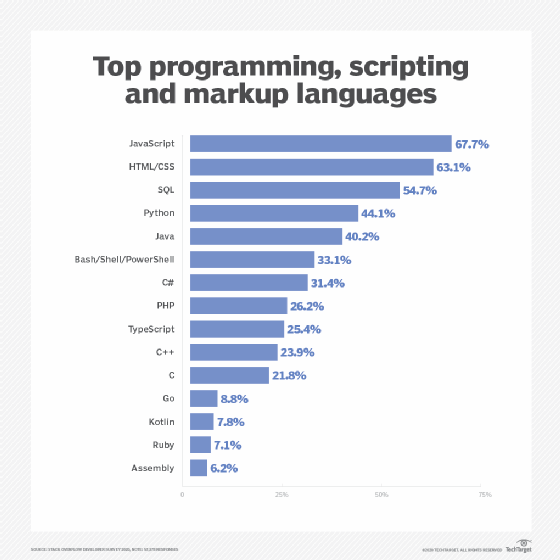
Maksim Kabakou - Fotolia
A comparison of 6 top programming languages
Choosing the right programming language can be tough. We place six popular languages head to head: Python vs. Ruby, Kotlin vs. Swift and Erlang vs. Elixir.
Developers have numerous programming languages to choose from, so much so that it can be overwhelming. Choosing the right -- or wrong -- language can make the difference between a software project's success and its failure.
While many programming languages may seem similar, no two languages behave the same way. Developers and architects need to look closely at the strengths and weaknesses of each option, including the tools, libraries and support behind those languages.
In this programming language comparison, we provide three direct face-offs between popular object-oriented, open source and concurrent programming languages. Read on to find the facts about:
- Python vs. Ruby
- Kotlin vs. Swift
- Erlang vs. Elixir
Object-oriented programming language comparison: Python vs. Ruby
Python and Ruby are popular options for developers, since they are both considered to be beginner friendly. But these languages were not created equal. Kerry Doyle, tech analyst, identifies the following as the biggest factors in their similarities and differences.
Python
Python is an object-oriented programming (OOP) language commonly used for web app development, scientific research, machine learning and FinTech. It's renowned for its easy code readability, access to well-documented libraries and large user community. Also, its repeatable code and automation capabilities promote simplified build processes. Its standout feature is the glue code it uses for server-side scripting, which helps strengthen communication between front-end and back-end components.
However, because it is an interpretive language, the conversion from source code to bytecode can create lag for compile times, system calls and kernel requests. And even though it runs on every major OS and domain, it is not the best choice for mobile apps right out of the box. Keep in mind, though, it is possible to find tool and library updates that can improve its mobile capabilities.
Ruby
Like Python, Ruby is a general-purpose OOP language that's considered easy to read and write. It performs well for small ad hoc scripting tasks, as well as front-end and back-end app development. Ruby is actually a blend of various languages, including Perl, Smalltalk, Eiffel, Ada and Lisp. It provides competitive portability capabilities, and can run on all platforms, including Unix, MacOS and Windows.
Ruby also uses Ruby on Rails, an open source web application framework which assists in builds for both front-end and server-side elements. Another standout feature is its garbage collection processes, which reduce memory utilization and fragmentation caused by multithreading processes. Unfortunately, Ruby's startup speed has been criticized for being slow. Developers have also complained about a lack of written documentation -- which, by comparison, is something that Python rests its laurels on. This means that developers who want to use Ruby will ideally need prior experience working in OOP.

Open source programming language comparison: Kotlin vs. Swift
Kotlin and Swift are two programming languages commonly associated with Android and iOS development. There are many similarities between the two, but each has its own advantages and limitations. According to Doyle, this is how they stack up against each other.
Kotlin
Kotlin is a statically typed programming language first created to streamline Android application development. Typically, it's used to build business-facing and commercial apps. It shares various attributes with Java, including its ability to run on Java Virtual Machine and integrate with Java classes.
A notable feature of Kotlin is its use of the Low-Level Virtual Machine (LLVM) compiler framework to optimize runtimes. Its Arrow library also gives developers access to patterns, type classes, data types and integration specifications.
Learning the language is relatively easy, thanks to its clean syntax and support from IntelliJ IDEA. However, the language is still more complex to learn than Java, and its small community provides a limited number of problem-solving resources.
Swift
Swift is a compiled programming language developed by Apple, but it also works for Android apps. It integrates with the Objective-C language, as well as Apple's Cocoa API and the Cocoa Touch development environment.
Swift promotes strict coding standards and inferring types, and the LLVM compiler enforces type safety that creates safe code. Swift's compiler also targets ARM and x86 architectures to support Android.
For those who are used to Linux, Swift may seem like an immature language. Its Linux and native libraries are limited, and it reportedly lacks a common build tool. Some developers also complain that Swift's constant updates make it difficult for developers to implement tools that consistently integrate with the language.
Concurrent programming language comparison: Erlang vs. Elixir
Erlang and Elixir are two popular concurrent programming languages designed to create highly available systems. Once again, Doyle explains the pros and cons of each language.
Erlang
Erlang is a concurrent and functional programming language famous for developing complex and highly available multithreaded systems. Originally designed to handle telecoms, the language has extended its reach into industries such as gaming, finance and healthcare. Erlang is also equipped to handle parallel processing, making it much easier to handle large volumes of application requests in a single moment.
One important component of this language is the BEAM, a virtual machine designed specifically for Erlang. BEAM's ability to diligently contain errors within individual nodes is an extremely useful feature for developers who must connect large numbers of concurrent nodes. Erlang is also celebrated for its garbage collection capabilities, where outdated code is removed through an automated process, minimizing the amount of unnecessary memory the application's code consumes.
The language's syntax can be challenging for beginners to understand, and there is a limited number of developer libraries to access. However, Erlang does share some similar libraries with Elixir, which provides a potential workaround to its complexity.
Elixir
Elixir is a concurrent programming language that bases its underlying structure on Erlang's BEAM. Through asynchronous messaging and the removal of shared memory, it ensures concurrent handling for requests moving through multiple cores and across nodes. Like Erlang, it also strives to sequester errors within the problem nodes. And as an immutable language, Elixir simplifies refactoring and debugging.
But while Elixir may be easier to learn compared to Erlang, it does not excel at performing sequential mathematic calculations. Because of this, it's not the best choice when it comes to CPU power consumption and processing speed. The Elixir community is also still relatively immature, limiting support and developer resources.








